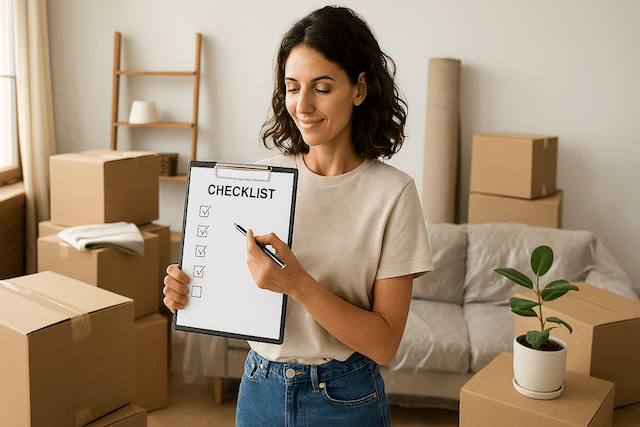Moving home is often regarded as one of life’s most stressful events. And whilst some people seem to take it all in their stride, there’s little doubt that the myriad of demands during the process can cause anxiety, even for the most organised of individuals.
The key to reducing the stress is simple: plan well ahead, be systematic, and stay organised.
Here’s a practical checklist of things to do to make the process less overwhelming – and to help you end up in a home you’ll love. (A FREE shortcut to download the list can be found at the end of the article)
Getting Started
1. Know what you want and write it down
- Before you even put your home on the market or start viewing properties, write a list of what you want to achieve:
- Where do you want to live?
- What type of property?
- How many bedrooms?
- Do you want a garden, parking, or to be close to schools or family?
- Would you be happy to renovate, or does it need to be move-in ready?
- Write it all down – and refer back to it regularly.
2. Declutter
- Sort through your belongings. Decide what you’re keeping, what you’re donating, and what you can discard.
- Don’t forget spaces like the loft, garage, and shed.
- Packing non-essential items early can save you time later – and a tidy, clutter-free home will make selling much easier.
3. Check your finances and set a budget.
- Start by getting an idea of your current home’s value. Use online tools like Zoopla or OnTheMarket to see what similar properties have sold for, then invite a few estate agents round for a professional opinion.
- Speak to your bank or a mortgage broker early to find out how much you can borrow and what your repayments would be.
- Write a budget, including:
- Mortgage fees
- Stamp Duty
- Moving costs
- Solicitor/conveyancing fees
- Ongoing costs like insurance, council tax, and utilities
- Importantly, make sure you understand how you will fund your deposit – usually 5-10% of the purchase price.
- Even if you are lucky enough not to require a mortgage – make sure you can afford all the extras and not just the purchase price.
Finding the Right Property
1. Talk to estate agents
- Local agents are plugged into the market and can often alert you to properties before they hit online portals.
- Build a relationship – it could make all the difference.
2. Use online property sites
- For those based in the UK Rightmove, Zoopla, PrimeLocation, OnTheMarket and Home.co.uk are your friends.
- Set up email alerts so you’re notified the moment something new is listed.
3. Walk the streets
- Physically explore the areas you’re interested in – on foot, not just by car. It’s the best way to get a real feel for the vibe, traffic levels, noise, and local amenities.
- Visit at different times of day and days of the week to get a full picture.
4. Talk to the neighbours
- If you see people while you’re exploring, don’t be shy! Say hello and explain you’re thinking of moving into the area.
- Locals can give you honest insights – and sometimes even tip you off about properties coming up for sale.
5. Write a letter to homes you love
- Spotted a dream home that isn’t on the market? Write a polite, friendly letter explaining you’re keen to buy and post it through the letterbox.
- You could snap up a home before it even hits the market – and the seller might offer a better price without estate agent fees involved.
6. Take photos
- Make a photographic record of areas, streets, and properties you like.
- When you’re visiting multiple homes and locations, photos will help you remember which was which.
Getting Your House Ready to Sell
1. Organise and Energy Performance Certificate (EPC)
- You must have a valid EPC when selling.
- It lasts for 10 years, so check if you already have one by searching online. If not, arrange for a new EPC early on.
2. Get valuations for your home
- Do your homework – check local sale prices online first.
- Invite at least three estate agents for valuations (they can vary wildly!) and choose who feels realistic and knowledgeable.
3. Decide how you’re going to sell
- Traditional estate agents can handle more of the legwork but charge higher fees (up to 2%).
- Online agents like Purple Bricks might be cheaper but often require more DIY effort from you, like hosting your own viewings.
- Pick the route that suits your lifestyle and budget.
4. Choose your solicitor or licensed conveyancer
- Get this lined up early to avoid delays.
- Solicitors and conveyancers both handle the legal side – the main difference is that conveyancers are property specialists.
- You don’t have to use the solicitor your estate agent recommends – shop around for quotes and reviews.
5. Tidy up outside and create kerb appeal
- First impressions matter!
- Cut the grass, weed the garden, clean the windows, sweep the doorstep, and touch up the front door if needed.
6. De-personalise and clean
- Pack away family photos, collections, and anything too personal.
- You want potential buyers to imagine themselves living there – not feeling like they’re intruding in your life.
7. Repair and refresh
- Fix broken handles, cracked tiles, and leaky taps.
- Neutral décor and a fresh coat of paint can make a huge difference to how a property is perceived.
- And don’t forget to eliminate strong odours – fresh, clean air is best.
Preparing for Sale and Purchase
1. Shortlist removal firms
- Get personal recommendations if possible.
- Compare quotes carefully – check if packing materials are included, and whether you save money by packing yourself or moving mid-week.
2. Prepare your documents
- Have these ready for your solicitor:
- ID documents
- Proof of address
- Property title deeds (if available)
- EPC certificate
- Warranty certificates for recent works (e.g. boiler installations)
- Take a look at The 10 Important Details Every Homeowner Should Keep Safe (and Where to Store Them Digitally)
3. Accept an offer and find your next home
- Once your home is under offer, you’ll be in a stronger position to offer on properties you like.
4. Organise surveys and checks
- Arrange for a property survey on the home you’re buying to avoid nasty surprises later.
5. Finalise your mortgage and insurance
- Complete your mortgage application and arrange home insurance ready for exchange of contracts.
Approaching Moving Day
1. Exchange contracts
- This is the point when the sale becomes legally binding. You’ll need to pay your deposit and agree on the completion date.
2. Book your removals firm
- Confirm the details and timings.
- Label all boxes clearly by room to make moving-in much easier.
3. Create a moving day essentials box
- Include things like:
- Important documents
- Kettle and mugs
- Phone chargers
- Snacks
- Cleaning supplies
- Basic tools
4. Notify all relevant organisations
- Update your address with:
- Banks
- Utilities
- DVLA
- Council tax
- Doctors, schools, subscriptions
- Set up a Royal Mail post redirection service to catch anything you miss.
Moving Day!
- Take final meter readings at your old property
- Pick up the keys to your new home
- Move in and celebrate – you’ve done it! 🎉
Download and Print your FREE Checklist from the Possum Pouch
💡 Life Possum is a great way to store all the important details you are likely to need when selling your home. The best way is to start early and build up your information over time (see How to Start Getting Your Property Organised (Without Feeling Overwhelmed) Even better, start collecting the information on your new home even before you move in!
💡Also, as a seller, you can use Life Possum’s “Transfer Property” feature to transfer your property and all the information you choose across your buyer. Saving them the early work of starting from a blank repository and also saving the need to pass across paper-based files.

